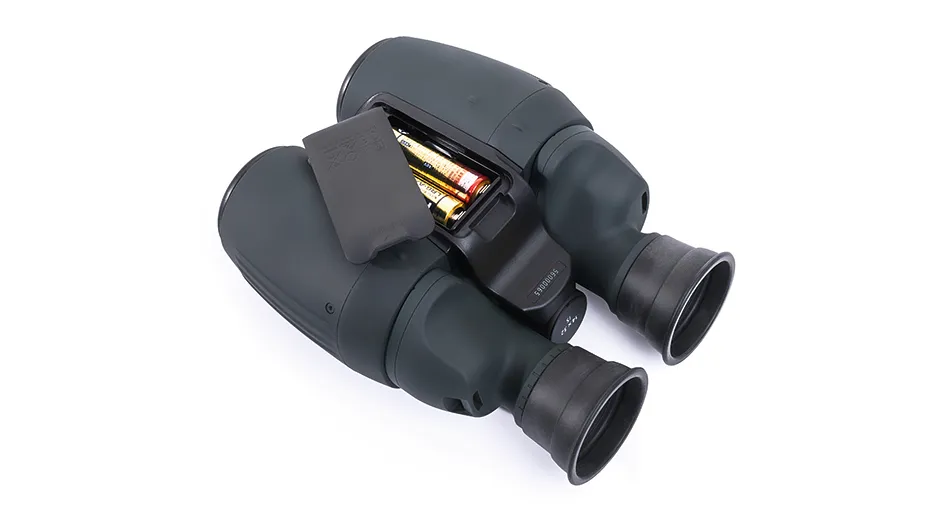Canon’s range of image-stabiliser (IS) binoculars is the first to incorporate the lens-shift system that the company uses in its EF camera lenses.
In theory, this should give an improvement over the previously used Vari-Angle Prism system of stabilisation, but does it deliver in practice?
We tested Canon’s 14x32 IS binoculars to see how well the new system works on the night sky.
The binoculars come in a soft, well-padded Cordura case and have a 30mm-wide neck strap that we found to be very comfortable, even against a bare neck.
There are no caps for the objective lenses but the dual eyepiece caps fit very well and are tethered to the neck strap by a short cord.
There’s also a comprehensive instruction manual provided in PDF format on a USB memory stick.
The binoculars are covered with a matte rubber armour that provides a secure grip, even when the binoculars are dew-dampened (although they’re not waterproof), and offers some impact protection.
There’s a rubber bumper around each objective lens to reduce the effects of front-end impacts.
The prism system is a Porro Type II, so you have to rotate the eyepiece turrets to adjust the interpupillary distance.
They, and the right eyepiece dioptre adjustment, move smoothly, with enough resistance to ensure that they won’t accidentally slip once they’ve been set.
The centre focus also has an action that’s light and smooth, with no perceptible backlash.
These binoculars appear on our list of the best binoculars for astronomy and stargazing

Lenses and light control
The eye-cups fold down to 3mm above the surface of the lenses, so only 11.5mm of the specified 14.5mm eye relief is available.
As a consequence, we were unable to see the entire 4.3° field of view when wearing spectacles.<
But the focal range of the binoculars extends several dioptres ‘beyond’ infinity, so most people with any sort of vision impairment should be able to focus the binoculars and observe without spectacles.
We found that the 2.3mm exit pupil is small enough to significantly reduce, but not completely eliminate, the effectof mild astigmatism.
When we shone a bright light into the objective lens there was only a tiny amount of light reflected from its surface and the components inside, which suggests that Canon’s proprietary Super-Spectra anti-reflective multi-coatings are effective.
The binoculars’ control of stray light is excellent: there were no spurious ghost images when the lunar terminator was held near the edge of the field of view.
There’s a small amount of off-axis chromatic aberration on the Moon and Venus, but generally both colour correction and colour rendition are very good.
Even with a gibbous Moon nearby, the different colours of the three brightest stars in Orion’s Meissa cluster (Lambda (λ), Phi-1 (ϕ1) and Phi-2 (ϕ2) Orionis) were distinct.
Stabilising the view
We panned over to the double star Iota (ι) Cancri (mags. 4.0 and 6.0, separation 30 arcseconds) and activated the image stabiliser.
The stars immediately split into the two components and they remained separated until they were close to the edge of the field of view, testifying to the efficacy of the field-flattener lens-group.
The laws of optics limit the capability of the 32mm aperture and, although the Orion Nebula (M42) was not particularly bright, it showed some structure when the image stabiliser was activated.
Here, binoculars really come into their own, however, is with open clusters and faint asterisms.
For example, M35 in Gemini initially appeared as a few stars resolved against a background fuzz but, with the image stabiliser engaged, the fuzz became distinctly granular as more stars approached resolvability.
When we activated the image stabiliser on the Pleiades or Kemble’s Cascade, not only did the image become still, but more stars became visible as we gained about a quarter of a magnitude in depth.
Incorporating the new image stabiliser system into these binoculars boosts their appeal and usefulness.
It helps make the Canon 14x32 IS a great choice for observers looking for multi-purpose, small-aperture image-stabilised binoculars to complement their main observing equipment.

Outstanding feature: Versatile image stabilisation
There are two different stabilisation modes, labelled ‘Stabiliser’ and ‘Powered IS’.
When you’re panning the sky, you use the Stabiliser mode, which eliminates shake, but doesn’t try to oppose large movements.
When you find your target, you switch to Powered IS mode, which compensates for both kinds of motion.
The combination of a sensitive two-axis gyro sensor and fast electronics means that stabilisation is almostinstantaneous when you press either stabilisation button.
The stabilisation system compensates for motion amplitude of up to 1º, so the image at 14x magnification is rock steady.
There are also two ways of using each stabiliser mode.
If you press and hold a stabiliser button, it will operate only as long as you hold the button down, but if you press and release the button, the stabiliser will stay on for five minutes in normal use; you can press it again to switch it off sooner.
To preserve battery life, each of the stabilisers switch off after 10 seconds if the binoculars are facing downwards.
Good IPD range
With the interpupillary distance ranging from 56-78mm, the Canon 14x32 IS will suit a wide variety of faces.
The wide eyepiece barrels mean that there’s only 8mm between the soft rubber eye-cups at the minimum interpupillary distance, so this may be uncomfortable for some people with close-set eyes.
Tactile button identification
A raised bump on the edge of the concave ‘Stabiliser’ button enables you to identify it by touch alone, even with gloved hands.
This makes it easy to distinguish it from the convex ‘Powered IS’ button and reduces the likelihood that you’ll inadvertently engage the wrong stabilisation mode.
Internal focusing
The focusing mechanism works by moving a lens group inside the body of the binoculars, which has the advantage of eliminating the need for an eyepiece bridge.
This makes it easier to seal the binoculars against dust and ensures that any pressure on the eyepieces won’t defocus the view.
Excellent optics
The combination of an internal field-flattener lens group and Canon’s proprietary Super-Spectra coatings, which reflect only a minimal amount of light and transmit the full visible spectrum, results in images that are sharp across the entire field of view.
Colour rendition isfaithful with very good contrast.
AA batteries
Although the binoculars can be used without power, the image stabiliser system is powered by readily available AA batteries so it should be easy to source replacements for years to come.
Vital stats
Price: £1399.00
Aperture: 32mm
Weight:775g
Supplier: Canon
Telephone: 020 8588 8000
Website:www.canon.co.uk
This review originally appeared in the March 2018 issue of BBC Sky at Night Magazine
